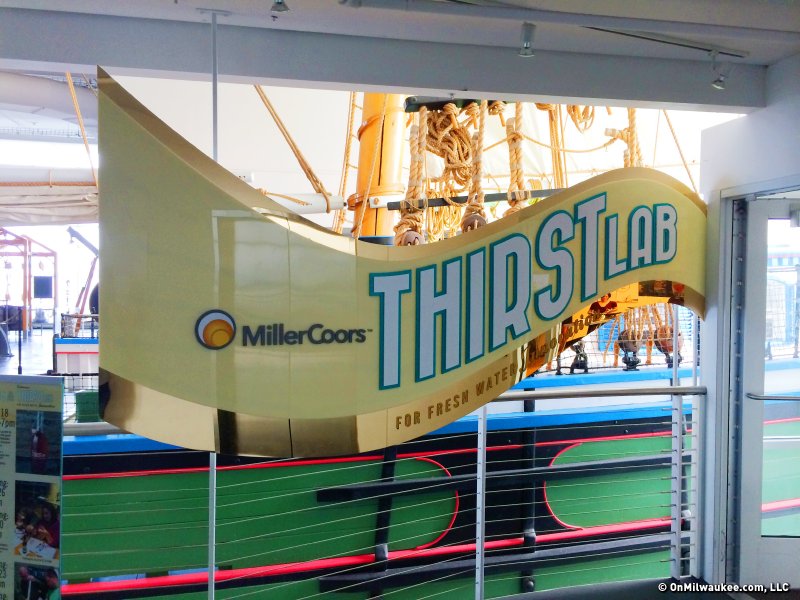When it comes to cocktails, I’m a dabbler. I’ve made my own limoncello. And every summer, I come up with a host of recipes for herbal simple syrups to use for enhancing cocktails, iced tea and lemonade. And right now, I have a two-quart canning jar on my counter that’s steeping a batch of rhubarb-infused gin. And yes, I’ve even purchased cinchona bark to make my own tonic.
But, I’ve never really delved into the science or history of tonics.
It’s part of the reason why I was so attracted to the idea of attending one of the latest workshops at the THIRST Lab at Discovery World.
If you’ve never been to the MillerCoors THIRST Lab, I’d recommend a visit. The purpose of the lab is to provide interactive experiences that assist participants in understanding the value of freshwater and its vital role in everyday products. But, its strength really lies in its capacity for providing hands-on learning for children and adults alike.
Filled with brewing tanks, hot plates and other great equipment, the lab is constructed specifically for instruction in all sorts of beverage making techniques. On this particular night, it was our fate to learn the ins and outs of making tonic.
The "Tonic Creations with Top Note Tonics" workshop was presented by Mary Pellettieri, co-founder and president of Top Note Tonics.
As a quality and sensory analyst in the brewing industry, Pellettieri spent the last twenty years focusing her energy on reducing risk for brewers including Chicago’s Goose Island Beer Co. and MillerCoors LLC, where she was business operation manager for the Tenth and Blake craft and specialty beer unit.
These days, Pellettieri is busy running Top Note Tonics, a Milwaukee-based company specializing in bitter sodas and tonic concentrates.
Pellettieri’s passion for the topic came through as she started off the workshop by sharing the storied – and relatively unknown – history of tonics and their evolution throughout the ages.
Once made from botanicals, with a reputation for offering health and rejuvenation, tonics played an important role in the evolution of the beverage industry.
First made and served in pharmacies, they were touted as medicinal "cure-alls," and enhanced with natural flavors and sugar to make them more palatable. But, as time wore on, tonics evolved into beverages that we now would recognize more readily as soda.
Modern day tonic water, known for its vital role in the classic "gin and tonic," is made from an infusion using cinchona, a natural source for quinine. It was actually derived for the purpose of preventing malaria. In fact, it’s said that the gin and tonic originated because doctors recommended adding gin to the tonic to make it taste better.
From the first bottled carbonated elixir, created by Jacob Schweppe in 1809, to Coca-Cola’s role in making the "bad" alcohol of prohibition taste better, to the sugary tonic waters available on today’s grocery shelves, Pellettieri walked participants through the history and science of the sparkling beverages known as tonics.
But, the evening didn’t end with a history lesson. Instead, the workshop progressed into a hands-on experience, including a guided tasting of both commercially available and Top Note tonics, as well as an opportunity for attendees to experiment making tonic syrup from botanicals like rhubarb root, cinchona bark, ginger, lemon and orange peel, gentian root, quassia, wintergreen and star anise.
The hour and a half flew by, and I found myself simultaneously geeking out over the wealth of information at my disposal and the opportunity to be creative with newfound ingredients. In the process, I got a chance to know a few of the other participants in the workshop, all of whom were just as engaged and excited as I.
I would have gladly paid the $25 workshop fee just for the information I gleaned; but, I went home with two bottles of tonic syrup, one filled with traditional syrup and the other filled with my own botanical concoction -- a rhubarb root-ginger tonic that I’m really stoked about trying out in some weekend cocktails.
Upcoming programming in the THIRST Lab includes:
June 26 – Goddess Brewing Series: Mbaba Mwana Waresa
Sept. 23 – Master Brewer Series: All-Grain Recipe
Oct. 16 – Master Brewer Series: 3 Sheeps Brewing
For more information about the THIRST Lab and other Discovery World programming, visit discoveryworld.org.
As a passionate champion of the local dining scene, Lori has reimagined the restaurant critic's role into that of a trusted dining concierge, guiding food lovers to delightful culinary discoveries and memorable experiences.
Lori is an avid cook whose accrual of condiments and spices is rivaled only by her cookbook collection. Her passion for the culinary industry was birthed while balancing A&W root beer mugs as a teenage carhop, fed by insatiable curiosity and fueled by the people whose stories entwine with every dish. Lori is the author of two books: the "Wisconsin Field to Fork" cookbook and "Milwaukee Food". Her work has garnered journalism awards from entities including the Milwaukee Press Club. In 2024, Lori was honored with a "Top 20 Women in Hospitality to Watch" award by the Wisconsin Restaurant Association.
When she’s not eating, photographing food, writing or planning for TV and radio spots, you’ll find Lori seeking out adventures with her husband Paul, traveling, cooking, reading, learning, snuggling with her cats and looking for ways to make a difference.







